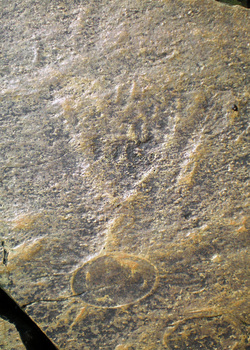PRIMOCANDELABRUM HIEMALORANUM
HOFMANN ET AL, 2008
|
Localities: Bonavista Peninsula, Newfoundland
Stratigraphic range: Description: Hofmann, O'Brien and King, 2008 About: Primocandelabrum, as the name suggests, bears the shape of a candelabrum, with branches that diverge near the base of the frond. This species of Primocandelabrum is found preserved with a basal holdfast which, when found in isolation is termed Hiemalora. Where other Rangeomorphs are thought to have had their holdfasts buried in the sediment, it is thought that P.hiemaloranum sat on the surface of the sediment, with root like structures emanating from its holdfast to hold it in place, making it unique. Key papers: Hofmann O'Brien and King., 2008 |
Diagnosis: Tripartite epireliefs characterized by basal discoidal or globular structure attached to a distinct stem that develops distally into an incompletely preserved, bush-like or candelabra-like frond with a general, overall triangular shape. Basal globular or discoidal structure outlined by a narrow raised marginal rim enclosing shallow depression with or without faint concentric markings; numerous (8-30) narrow, straight to slightly sinuous or bent ray-like appendages radiating from disc rim. Diameters of four discs observed 2.5, 3.2, 4.2 and 7.8cm, length of processes about equal to disc diameter. Stem length (distance between disc center and frond) 3.7, 5.3, 6.0 and 12.4cm, similar to disc diameter, width uniform, respectively 0.5, 1.6, 0.8 and 3cm. Fronds incomplete, proximal portion forming acute to approximately right angles, preserved length about double the stem length (minima respectively 8.5, 10.5, 15.0 and 23.5cm), widths 4.7, 7.0, 7.2 and 20cm. Frond with poorly defined, coarse, distally diverging ridges and intervening depressions; two depressions in one specimen with faint transverse markings 3mm wide (fig 12.3) (from Hoffman, O'Brien and King, 2008)

